

Dark Energy, Dark Matter. Dark Energy, Dark Matter In the early 1990s, one thing was fairly certain about the expansion of the Universe.
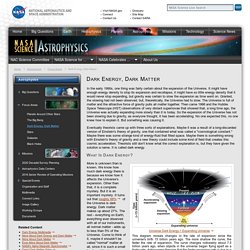
It might have enough energy density to stop its expansion and recollapse, it might have so little energy density that it would never stop expanding, but gravity was certain to slow the expansion as time went on. Granted, the slowing had not been observed, but, theoretically, the Universe had to slow. The Universe is full of matter and the attractive force of gravity pulls all matter together. Then came 1998 and the Hubble Space Telescope (HST) observations of very distant supernovae that showed that, a long time ago, the Universe was actually expanding more slowly than it is today.
Eventually theorists came up with three sorts of explanations. What Is Dark Energy? More is unknown than is known. One explanation for dark energy is that it is a property of space. LA Times. High above the spiral Milky Way, astronomers have spotted two clusters of new stars growing at the fringes of our galaxy.

The discovery, published in the journal Monthly Notices of the Royal Astronomical Society, appears to be the first such stellar cradles found outside the galactic disk. Living so far off the disk has its perks: If aliens lived on planets around these young stars, they’d get a spectacular bird's-eye view of the Milky Way, pinwheel arms and all. (By comparison, Earthlings with a clear view see the Milky Way as a band across the night sky – a beautiful but less-shapely sight.) The clusters, called Camargo 438 and Camargo 439, were found inside a high-latitude molecular cloud made mostly of hydrogen and named HRK 81.4-77.8. The giant cloud is thought to be about 2 million years old and sits about 16,600 light-years away, high above the galactic disk.
Scientists identify mineral that destroys organic compounds, with implications for Mars Curiosity Mission. Scientists have discovered that the mineral jarosite breaks down organic compounds when it is flash-heated, with implications for Mars research.
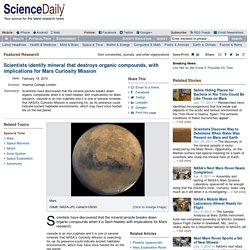
Jarosite is an iron sulphate and it is one of several minerals that NASA’s Curiosity Mission is searching for, as its presence could indicate ancient habitable environments, which may have once hosted life on the red planet. In a new study published today in the journal Astrobiology, researchers from Imperial College London and the Natural History Museum replicated a technique that one of the Curiosity Rover’s on-board instruments is using to analyse soil samples, in its quest to find organic compounds. They tested a combination of jarosite and organic compounds. Physicists offer a solution to the puzzle of the origin of matter in the universe. Most of the laws of nature treat particles and antiparticles equally, but stars and planets are made of particles, or matter, and not antiparticles, or antimatter.
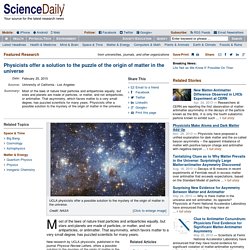
That asymmetry, which favors matter to a very small degree, has puzzled scientists for many years. New research by UCLA physicists, published in the journal Physical Review Letters, offers a possible solution to the mystery of the origin of matter in the universe. Alexander Kusenko, a professor of physics and astronomy in the UCLA College, and colleagues propose that the matter-antimatter asymmetry could be related to the Higgs boson particle, which was the subject of prominent news coverage when it was discovered at Switzerland's Large Hadron Collider in 2012. If a particle and an antiparticle meet, they disappear by emitting two photons or a pair of some other particles. Life 'not as we know it' possible on Saturn's moon Titan. A new type of methane-based, oxygen-free life form that can metabolize and reproduce similar to life on Earth has been modeled by a team of Cornell University researchers.
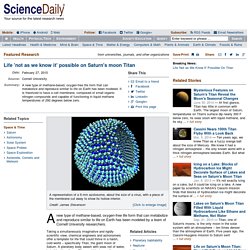
Taking a simultaneously imaginative and rigidly scientific view, chemical engineers and astronomers offer a template for life that could thrive in a harsh, cold world -- specifically Titan, the giant moon of Saturn. A planetary body awash with seas not of water, but of liquid methane, Titan could harbor methane-based, oxygen-free cells. Their theorized cell membrane, composed of small organic nitrogen compounds and capable of functioning in liquid methane temperatures of 292 degrees below zero, is published in Science Advances, Feb. 27. The work is led by chemical molecular dynamics expert Paulette Clancy and first author James Stevenson, a graduate student in chemical engineering. The paper's co-author is Jonathan Lunine, director for Cornell's Center for Radiophysics and Space Research. 'Diamond' Planet May Not be Such a Gem.
A planet 40 light years from our solar system, believed to be the first-ever discovered planet to consist largely of diamond, may in fact be of less exquisite nature, according to new research led by University of Arizona astronomy graduate student Johanna Teske.
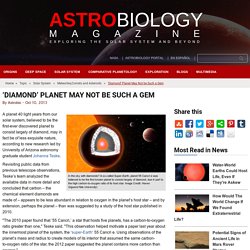
Revisiting public data from previous telescope observations, Teske’s team analyzed the available data in more detail and concluded that carbon – the chemical element diamonds are made of – appears to be less abundant in relation to oxygen in the planet’s host star – and by extension, perhaps the planet – than was suggested by a study of the host star published in 2010. "The 2010 paper found that ’55 Cancri,’ a star that hosts five planets, has a carbon-to-oxygen ratio greater than one," Teske said. "This observation helped motivate a paper last year about the innermost planet of the system, the ‘super-Earth‘ 55 Cancri e. "This planet is probably rocky or has a large rocky component," she said.
Russia will begin Moon colonization in 2030 - draft space program. A new Earth: 10 NASA images of planets like Earth. Humankind on Mars - Mission.